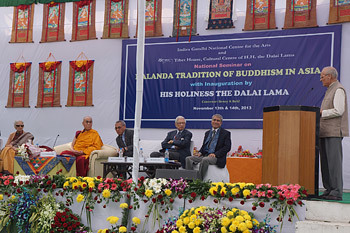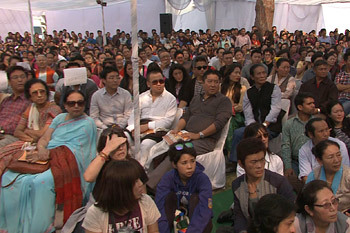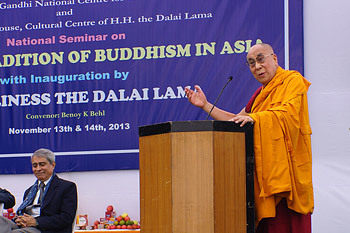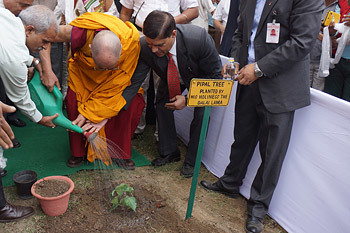New Delhi, India, 13 November 2013 - Shortly after arriving in Delhi from Dharamsala today, His Holiness the Dalai Lama drove to the Indira Gandhi National Centre for the Arts (IGNCA) where he had been invited to inaugurate a two day national seminar on the Nalanda Tradition of Buddhism in Asia. He was received by Geshe Dorji Damdul, Director of Tibet House, and escorted through the IGNCA grounds by the convenor of the event Benoy K Behl and his old friend Dr Kapila Vatsyayan.
In her opening remarks the moderator spoke of a profusion of universities during the medieval period in East India, Odantapuri, Vikramashila, Somapuri and the crown of them all Nalanda. These centres of learning were custodians of a universal knowledge that remains relevant today. A focus of the present seminar, she said, was a film by Prof. Benoy K Behl celebrating the way Tibetans have preserved the culture of Nalanda.

|
President of the IGNCA, Chinmaya Gharekhan welcomes His Holiness the Dalai Lama to the inauguration of a two day national seminar on the Nalanda Tradition of Buddhism in Asia in New Delhi, India on November 13, 2013. Photo/Jeremy Russell/OHHDL
|
President of the IGNCA, Chinmaya Gharekhan in his welcoming address praised His Holiness as a “guide for humankind”, as a living example of the Nalanda tradition that had spread across Asia. In his turn, Director of Tibet House, Geshe Dorji Damdul, asked, “How is it that Nalanda is so widely spoken of today? It is because of His Holiness’s proclaiming its qualities and its having been a thriving centre of knowledge.” He pointed out that in addition to the philosophical discussions that took place there, which bear comparison with contemporary explorations of relativity and psychology, a key factor in Nalanda’s effectiveness was its promotion of the use of logic, the rigour of epistemology, as a method of learning and investigation.
Before showing a trailer of his film about Nalanda, Prof. Benoy K Behl acknowledged the contribution of Prof. Geshe Ngawang Samten, Vice Chancellor of the Central University of Tibetan Studies, Sarnath, who inspired the project and introduced him to Geshe Dorji Damdul and the IGNCA. He expressed pride at being involved in a reawakening of the precious life and thought of Nalanda.
In his address to the meeting, His Holiness first paid homage to the Buddha, reciting a few lines in Tibetan. Then he congratulated the Indira Gandhi National Centre for the Arts and Tibet House for organising this event focussed on Nalanda. He recalled that when he first had the opportunity to come to India in 1956, he made a pilgrimage to various sites including Nalanda.

|
| Audience members listening to His Holiness the Dalai Lama address the inauguration of a two day national seminar on the Nalanda Tradition of Buddhism in Asia in New Delhi, India on November 13, 2013. Photo/Lobsang Tsering/OHHDL |
“The name Nalanda was very familiar to me as the source of the tradition we follow in Tibet. First we memorize the root text, then study it word by word and then debate it with our fellow students to penetrate the depths of its meaning. I began this process myself as a child of 6 or 7 years old, reluctantly to begin with. However, in due course, I became more interested and developed a great admiration for the works of the Indian masters who are part of this tradition. The great Buddhist institution of Nalanda now lies in ruins, yet the knowledge it fostered, based on the Buddha’s teachings, contributed immensely to Buddhist understanding, particularly in its Sanskrit tradition. This was the tradition that spread to China and later to Tibet. Only insects and pigeons live in the ruins today, but the knowledge that flowed from this place survives. Through rigorous study and practice, the Nalanda tradition was kept alive in Tibet.
“The Buddha counselled his followers to be sceptical, to critically examine what he told them, not to accept what he said merely in good faith. Nagarjuna, Aryadeva, Buddhapalita, Chandrakirti and Shantideva took this advice to heart. They made an effort to investigate and understand reality. Today, science has evolved in the West among scientists who engage in a correspondingly strict investigation of reality. Despite cautions that ‘science is the killer of religion’, I began conversations with scientists more than thirty years ago. Today, many of them are showing interest in, for example, ancient Indian knowledge of the mind.”

|
His Holiness the Dalai Lama addressing the inauguration of the two day national seminar on the Nalanda Tradition of Buddhism in Asia in New Delhi, India on November 13, 2013. Photo/Jeremy Russell/OHHDL
|
He elaborated on this saying that ancient Indian texts contain a thorough knowledge of our emotions. Once the source of an emotional problem is understood, it’s much easier to solve it. This is one of the reasons why knowledge from the Nalanda tradition is relevant in today’s world. His Holiness said that as far as understanding our inner world is concerned India has a significant contribution to make.
“We Tibetans regard ourselves as chelas of Indian gurus, ancient Indian gurus. And although much of the knowledge I speak of is to be found in Buddhist literature, it is not strictly Buddhist, but has a secular basis. India is multi-religious society and has long maintained a profound respect for different religious traditions. As an extension of this we should pay more attention to our inner values; if we are slaves to money, for example, we’ll have no peace of mind. As human beings, we have to look after one another. We have to think and analyse, which gives rise to self-confidence and overcomes fear. I’m not talking about the next life, but about ensuring our minds are healthy now. In trying to create a better world, we need to have less emphasis on ‘them’ and ‘us’ and more sense that everyone is part of ‘us’.”
“I’m proud to be a chela of those great ancient India thinkers,” His Holiness reiterated. “I call myself a son of India because while my brain has been filled with ancient Indian thought, my body has been nourished for decades by Indian rice, dal and chapattis.

|
His Holiness the Dalai Lama planting a peepal sapling following the inaugural meeting of the two day national seminar on the Nalanda Tradition of Buddhism in Asia in New Delhi, India on November 13, 2013. Photo/Jeremy Russell/OHHDL
|
“I hope meetings like this will serve to remind us of the value of what Nalanda represented. Some scientists have asked me if we can apply Nalanda’s logical approach to study in other fields, and I can’t see why not. We need analysis, taking a broad view of whatever it is we’re investigating, looking at it from many angles.”
Following this inaugural meeting, His Holiness planted and watered a peepal sapling that had been brought from Nalanda as a memento of the occasion. He then visited an exhibition of photographs of Buddhist sites taken by Prof. Benoy K Behl, at the centre of which monks of Drepung Loseling Monastery had constructed a sand mandala. He duly recited words of consecration over it.
His Holiness continued to hold animated conversation with Benoy Behl and Kapila Vatsyayan about Nalanda and a project to compile a book focussing on Buddhist science as they accompanied him to his car. The path was thronged with Tibetans, Indians and foreigners eager to catch a glimpse of him. Before climbing into the car he turned and spoke effusively to assembled Tibetans about the inestimable qualities of the Nalanda tradition preserved so accurately and rigorously in Tibet.
















